How to Stock a Vegetarian Pantry
A simple guide to how to stock a vegetarian pantry – all the store cupboard items you’ll need to have on hand to allow you to make a tasty vegetarian meal any day of the week.
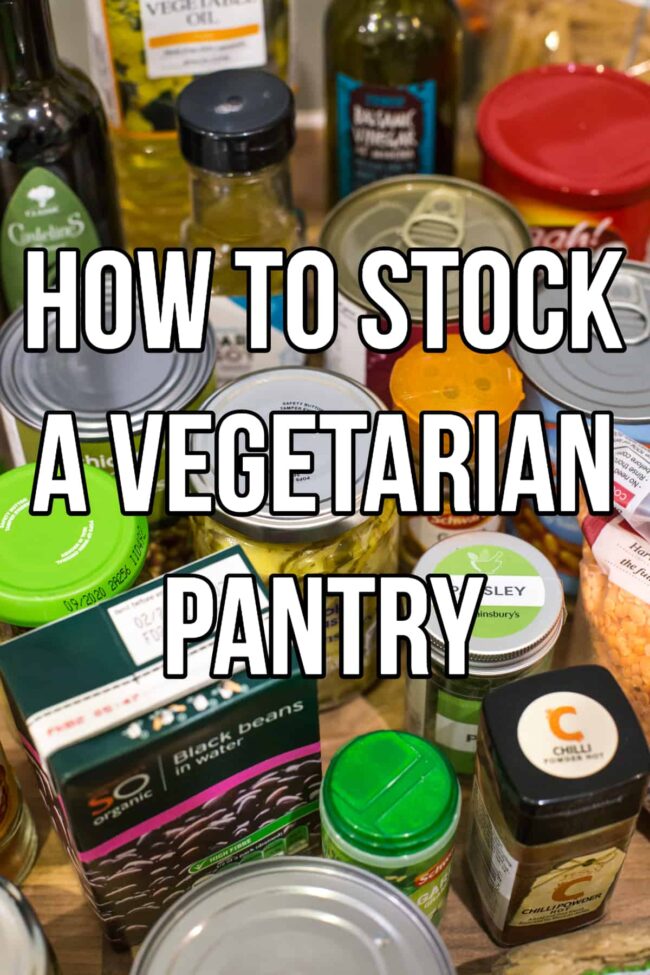
If you’ve had your own kitchen for years, you probably already have a well-stocked and well-organised pantry, and you already know what sorts of ingredients you use often. But if you’re new to cooking or new to vegetarianism, or perhaps you’ve only just moved out on your own, you might be wondering how to stock a vegetarian pantry – what sorts of things are the must-haves that you’ll probably want to keep in your cupboards at all times?
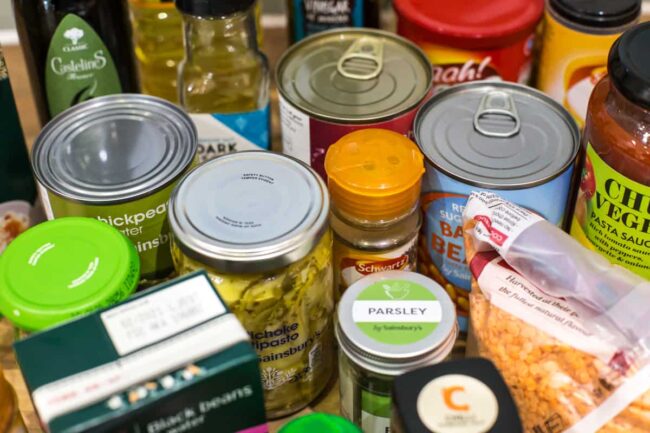
My real vegetarian pantry
This post was truly written about my own kitchen cupboards – I didn’t buy anything specially to write this post. I may have hidden the odd bar of chocolate, just because that’s not a necessity in everyone’s pantry (or is it…?), but otherwise, these photos show the real contents of my kitchen cupboards.
Just for the record, this post is not sponsored by any particular brand or supermarket! Quite a lot of the products come from Sainsbury’s, just because that’s where I’ve mostly been shopping since we moved house a couple of months ago, but there are plenty of items from other supermarkets too, as well as a few branded products. Generally I’ll buy the supermarket’s own brand products to save money.
I’ve broken this post down into categories to make it easier to browse – tins, jars, etc. Of course I also have some items stored in my fridge and freezer, but generally the long-life items that I keep in my kitchen at all times are just stored in my kitchen cupboards.
I’d love to hear how you stock your vegetarian pantry, if there’s anything I’ve missed!
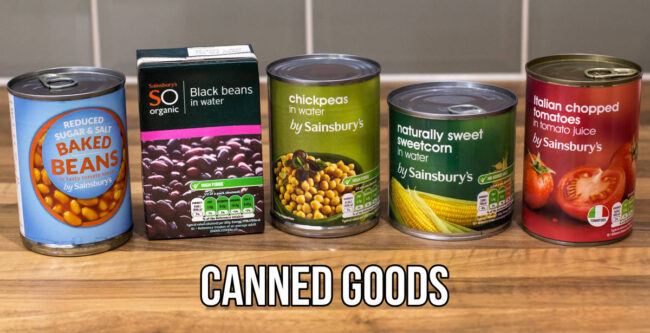
Canned goods
- tinned beans – great for throwing into stews, casseroles, pasta dishes, soups, etc. to add protein. I usually have a few different varieties in my cupboard, but most commonly I buy tinned black beans, kidney beans, and chickpeas. Try to get ones canned in water, without added salt.
- baked beans – if you’re not in the UK, you can probably ignore this one! But baked beans* are a staple in most British households. They’re a great easy side dish for all sorts of meals, or I also like to add them to stews and casseroles for extra flavour.
- tinned sweetcorn – I always have some corn in the cupboard for days when there aren’t many fresh veggies left in the fridge. So convenient for adding to pasta, casseroles etc. too.
- tinned tomatoes – if you have a tin of chopped tomatoes, you can make pasta sauce, curry, soup, etc. – a very useful thing to keep in the cupboard.
- other tinned vegetables – I rarely use other tinned veggies (I generally prefer frozen), but it can be handy to keep a tin of peas or potatoes for a quick dinner.
- tinned soups – always good to keep in the cupboard for an easy lunch!
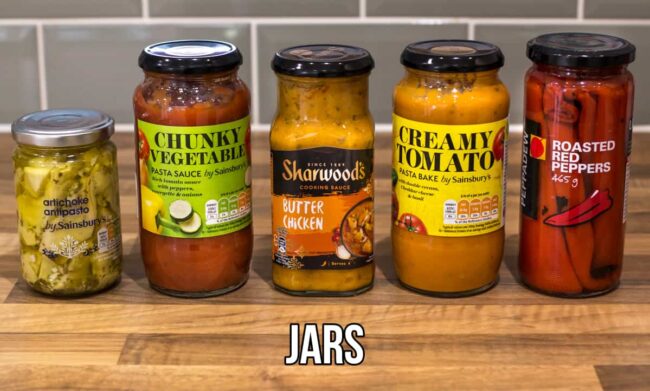
Jars
- jarred sauces – I always keep a few jars of sauce in the cupboard for quick and easy dinners. I do like to make my own sauces when I have time, but a jar of curry sauce or tomato sauce is so useful to have on hand for busy nights.
- jars of pesto – pesto makes a great pasta sauce (I love it on tortellini especially!), and is also great to use as a sandwich spread, stirred through soups and sauces, and to add flavour to all sorts of stews.
- jarred antipasti (e.g. capers, olives, artichokes, roasted peppers, etc.) – these aren’t things I use super often, but I like to keep a couple of jars of antipasti in the cupboards for times when I need lots of flavour quickly. They’re perfect to add to sandwiches, stir through pasta, or just serve on a snack platter if you have last-minute guests.
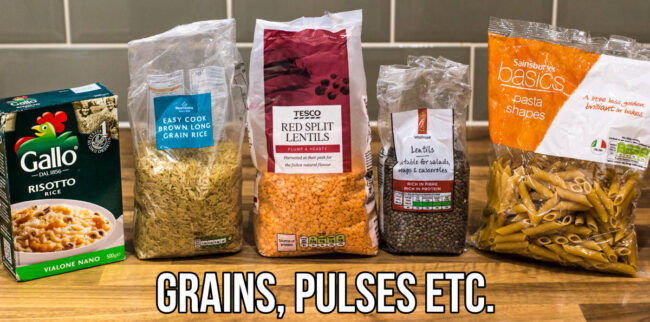
Grains, pulses etc.
- pasta – obviously! I always have a few different pasta shapes in the cupboard – both everyday shapes like penne and fusilli, and more specialist shapes like lasagne and cannelloni. Pasta makes a great focal point for a meal, so as long as you have pasta in the cupboard, you can make something decent.
- rice – both white and brown. Makes a nice change from pasta, and goes great with anything Mexican, Chinese, or Indian.
- arborio rice – I also always have risotto rice in the cupboard. You can make a good risotto with basically any vegetable, so just like with pasta, if you have arborio rice in the house, you can make a respectable meal.
- red lentils – my favourite kind of lentil! Red lentils cook down pretty soft, so they’re great for adding protein to sauces, and making soups and lentil casseroles.
- brown lentils – these hold their shape better than red lentils as they cook, so it’s worth having both in the cupboards – they feel like a completely different thing. Brown lentils are great for casseroles and stews.
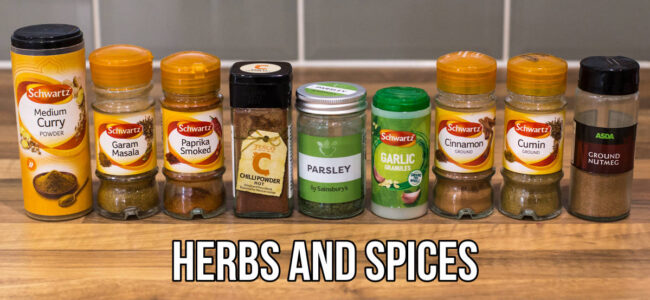
Herbs and spices
The herbs and spices you need will depend on what sort of cooking you do most – for example, Indian food will use different spices to Mexican food. If you’re not too concerned with authenticity, and you just want to make a tasty meal, you only really need 2-3 spices per cuisine to make a decent meal.
Here are my favourites to use for each cuisine (not necessarily authentic, but good enough to make a tasty meal!):
- Mexican food – ground cumin, smoked paprika (my favourite spice ever!), chilli powder
- Indian food – garam masala, ground cumin, ground coriander, curry powder
- Chinese food – Chinese 5 spice
- Italian – dried thyme, dried oregano, garlic granules
- Sweet foods e.g. baked goods or sweet breakfasts – ground cinnamon, ground nutmeg
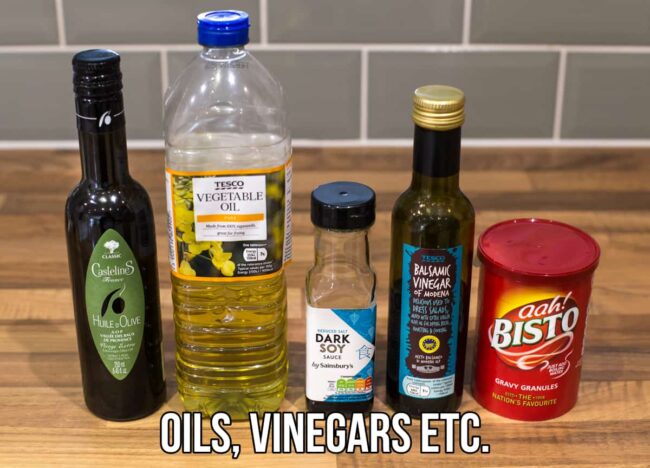
Oils, vinegars etc.
- cooking oil – I use vegetable oil (same as rapeseed oil / canola oil), but you can use any oil with a high smoke point for high-temperature cooking.
- extra virgin olive oil – less good for cooking, but has a lovely flavour so is perfect for making dressings etc.
- soy sauce – great for adding a rich salty flavour to stir fries, rice, or anything remotely Chinese-inspired.
- balsamic vinegar – add to tomato sauces, salad dressings, or drizzle over anything Italian-style for plenty of extra flavour.
- Bisto gravy granules* – another must for British households! As well as making a standalone gravy for bangers and mash, I also add gravy granules to stews and casseroles to thicken them and add heaps of flavour.
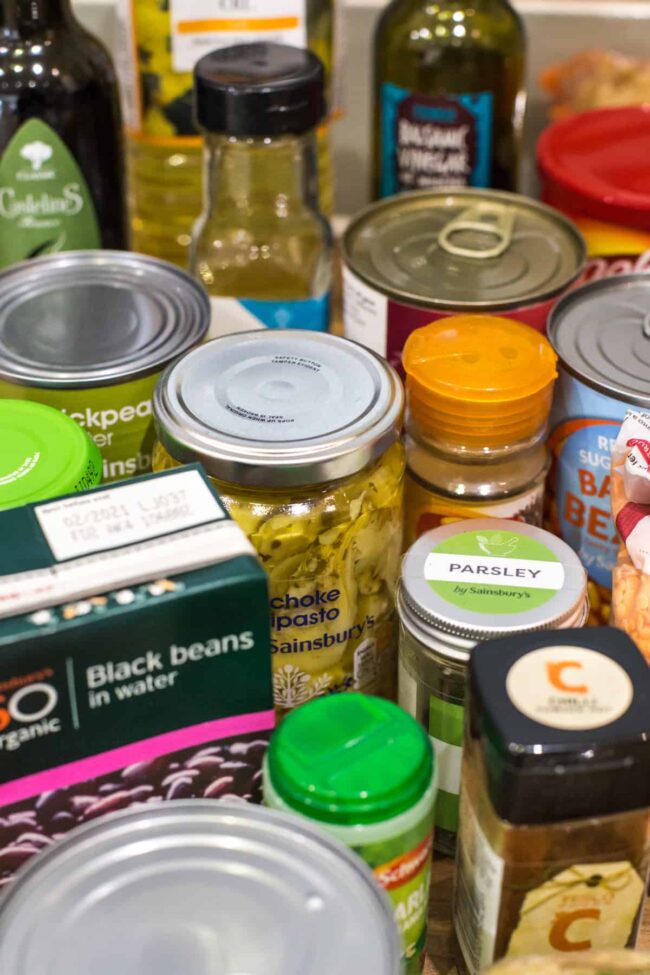
How else do you stock your vegetarian pantry?
If you have any other must-have items in your vegetarian pantry that you think I should add to this list, I’d love to hear your suggestions!
Remember, these are just the basic items that I like to keep in my store cupboard at all times. This is not an exhaustive list of the items in my cupboard, just the things I always make sure I have on hand. I can just add a few fresh veggies, and I know I’ll always be able to make a tasty vegetarian meal.
* This post contains affiliate links. As an Amazon Associate, I earn from qualifying purchases.

What about Lipton onion soup mix, vegetable broths
Ooh yes definitely some vegetable stock cubes too! I’ve never heard of onion soup mix though.
We love haloumi (husband half Greek) . Read through your whole pantry site, wish we could get the gravy granules in Australia! Thank you for making it so easy to print your recipes, just one page not excessive ingredients, not hours in the kitchen! Thanks again Maggie.
Thanks Maggie! That’s always my aim – I don’t like spending hours in the kitchen any more than anyone else :D
Frozen corn in Canada, never canned. But you forgot peanut butter!! not only a staple on it’s own, but also great in soups & sauces. Oatmeal – breakfats, sweet & savoury crisps.
Peanut butter is a good one! :)
Cartons (box?) of tofu? Not the fresh stuff. I keep a couple of cartons next to my beans as an alternative for protein.
I also have a selection of dried lentils/beans/ dals. I’m new to semi-vegy so I find a variety in the pulse size/shape/texture stops meals from feeling same-y.
Every time I search for vegy recipes, I end up back at your site. Thanks again!
Interesting, I’ve not tried a box of tofu before! I always buy the fresh stuff.
Mushroom ketchup.
Pomegranate molasses. Small tins of sweetcorn (the kind sold in packs of 3) are great for adding a bit of crunch to soups, although you can use frozen – I tend to use tinned because I have a soup machine, and you don’t need to reheat the soup if you’ve added a tin, whereas you do if you’ve added frozen!
White wine and cider vinegars to ring the changes on your salad dressings – the latter makes a fabulous honey mustard dressing. Oh yes, dry mustard powder, so essential for salad dressings and cheese sauces.
I need to try mushroom ketchup, that’s the second time I’ve seen it mentioned today!